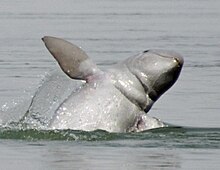Irrawaddy dolphin
| Irrawaddy dolphin | ||||||||||||
|---|---|---|---|---|---|---|---|---|---|---|---|---|

Irrawaddy dolphin |
||||||||||||
| Systematics | ||||||||||||
|
||||||||||||
| Scientific name | ||||||||||||
| Orcaella brevirostris | ||||||||||||
| ( Owen in Gray , 1866) |
The Irawadidelfin ( Orcaella brevirostris ) is a dolphin from the order of the whales that lives mainly in Asian coastal regions . There was long disagreement about its assignment. In some places it is also called the river pig.
features
The body length of this dolphin is 2.30 meters, very large specimens can be up to 2.75 meters long. The weight can reach 150 kilograms. The round head without the typical dolphin snout resembles the head shape of the white whale . If the body color is predominantly gray, there are different variants from pale whitish gray to dark slate gray.
distribution
Although it is named after the Irrawaddy River , it is not a real river dolphin.
Most populations live near the coast in bays and river deltas, occasionally swimming upriver, but others stay in rivers such as the Mekong for a long time . While the former have their habitat on the coasts of Bangladesh , Myanmar , Thailand , Cambodia , Vietnam , Malaysia , Indonesia , Palawans , New Guinea and Northern Australia , the population in the Mekong even reaches the Laotian river section starting from Cambodia .

Way of life
Irrawaddy dolphins do not have long diving times, about every minute they come to the surface, only showing their head and back, to catch their breath. Their diet consists of crustaceans that are dug up from the bottom mud. Fish and cephalopods are also eaten. Like other dolphins, they live in schools that consist of up to six animals, in isolated cases a maximum of 15 specimens have been observed. Occasionally, individual animals are seen, especially in the rivers. The neck is flexible.
Danger
Little is known about the population numbers. According to a WWF census from 2011, only 85 specimens lived in the Mekong . Figures from 2016 speak of 80 specimens and the possibility of a recovery in the population.
The Iraqi dolphin is under protection in most of the countries in its range. However, it often gets caught in fishing nets and suffocates. In some areas, such as the Mekong Delta , it was almost wiped out as a result. The IUCN also classifies the geographically isolated population in Malampaya Sound on Palawan as endangered ("vulnerable"). Sedimentation , heavy shipping traffic and environmentally harmful fishing methods are decisive reasons for the steady decline in the population.
There is also a link between the pollution of the animal habitat and its endangerment. Among other things, the toxins DDT and PCB affect the young animals, which ingest them through their mother's milk.
Protected area on the Mekong River
In August 2012, the Cambodian government decided to dedicate a 180 km long sanctuary to the Mekong's Irrawaddy dolphins. It stretches from the Kratie Province in eastern Cambodia to the border with Laos. Although fishing is still permitted in this section of the river, the use of raft houses, net baskets and fishing nets is prohibited. In 2014, Laos announced plans to build another dam in the Mekong dolphin habitat, which would further endanger the species.
Taxonomy
Because of its striking similarities to the white whale , the Irrawaddy dolphin has occasionally been assigned to the (actually) arctic gudgeon whales . On the other hand, due to its uniqueness, a separate family, the Oracellidae, was postulated. Currently, zoologists practically agree to classify it taxonomically as a real dolphin.
Which family group he belongs to within the dolphins remains largely controversial. Due to its missing beak, it could be a close relative of the pilot whale , but genetic studies see it as a close relative of the killer whale .
Individual evidence
- ↑ Pam J. Stacey, Peter W. Arnold Orcaella brevirostris. (PDF; 1.0 MB) In: Mammalian Species (American Society of Mammalogists). 616, 1999, pp. 1-8.
- ↑ Irrawaddy dolphin ( Memento of the original dated December 7, 2008 in the Internet Archive ) Info: The archive link was inserted automatically and has not yet been checked. Please check the original and archive link according to the instructions and then remove this notice. on arkive.org (English)
- ↑ Boris Culik: Orcaella brevirostris (Gray, 1866). ( Memento of December 5, 2004 in the Internet Archive ) In: Review on Small Ceaceans. CMCS, Bonn 2000 (English)
- ↑ Mekong dolphins severely threatened. WWF Germany , August 18, 2011, accessed July 3, 2016 .
- ↑ Endangered dolphins in baby luck. WWF Germany, June 30, 2016, accessed July 3, 2016 .
- ↑ Dolphins in the Mekong before extinction. WWF Germany , June 18, 2009, accessed July 3, 2016 .
- ↑ Cá heo sông Mekong được bảo vệ , vnexpress.net, August 24, 2012.
- ↑ Dam in Laos: Death blow for the last Mekong dolphins. WWF Germany, February 26, 2014, accessed July 3, 2016 .
Web links
- Orcaella brevirostris in the endangered Red List species the IUCN 2008. Posted by: RR Reeves u. a., 2008. Retrieved February 24, 2009.
